TheWrap’s Top 50 Film Schools for 2023
This list of the top film schools in the United States in 2023 first appeared in the College Issue of TheWrap magazine.
Apples and oranges? Sure. Trying to rank the top American film schools is fiendishly difficult, maybe even impossible, because of the vast difference between what the schools are trying to do. Our No. 1, AFI, is a conservatory that offers graduate studies to fewer than 200 students; No. 2, USC, has more than 1,500 students in seven different areas of both undergraduate and graduate study. The list includes conservatories and public universities, film studies programs and art schools, schools that are great for animation and ones that are great for documentaries, places where you can learn how to make movies and places where you can learn how to think about them. A brilliant home for one student could be a disaster for another — and while there’s a school on this list that’s right for you if you want to study visual media, factors that go well beyond the school’s position on these pages should go into that choice.
In terms of methodology, we reached out to every school on the list (plus some not on it) to collect information on everything from student body diversity to class size to scholarships to networking opportunities to alumni success, with a particular eye for info about new facilities, programs and faculty members since last year. We went over our findings in honest, off- the-record conversations with top film-school professionals and experts in an attempt to find some kind of consensus about who’s up, who’s down and who we might be overrating or overlooking. It took a lot of outreach and a lot of talking before we came up with the list you see here, which was assembled by Executive Editor, Awards Steve Pond, Deputy Awards Editor Missy Schwartz, Deputy Magazine Editor Steve Root and Contributing Editor Ben Svetkey, among others. (As a part-time professor at Chapman University, Svetkey recused himself from the ranking process.)
Read on to see who’s moving up, who’s sliding down and what the priorities are for the top schools in this stormiest of times in the entertainment industry.
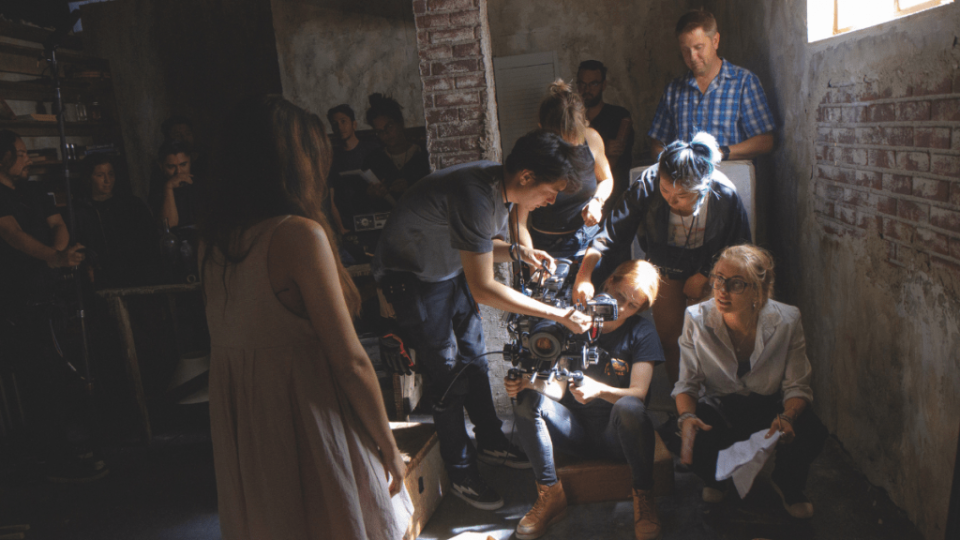
1. AMERICAN FILM INSTITUTE Los Angeles, CA
AFI emphasizes practicality: Its ethos is “learn by doing.” The conservatory honors that pledge with about 175 student films made at the school each year. Every first-year student gets $21,000 to make three shorts and $13,000 in the second year for their thesis films. The best are showcased at the annual AFI Fest, which attracts a wide range of industry players looking for new talent, many of them AFI alumni. The school touts the power of that network; about 50% of alumni have made donations to the school. Every year AFI has alumni sprinkled throughout the Oscar nominations. Diane Becker ’06 won in the Best Documentary Feature category for “Navalny,” Daniel Dreifuss ’07 and Thorsten Schumacher ’01, producer and executive producer, won Best International Feature Film for “All Quiet on the Western Front” and Todd Field ’92 scored three noms (director, screenplay and picture) for “Tár,” to cite three recent examples. Tuition costs $68,103 but almost 60% of students get some financial aid from a $2 million fund. The student body is diverse, with women comprising about 60% of the class and 40% coming from abroad. Roughly half of the American students are people of color. AFI has recently taken the lead in organizing the Film School Safety Pledge to foster safer production environments.
2. UNIVERSITY OF SOUTHERN CALIFORNIA Los Angeles, CA
It’s a cliché to call something “the Harvard of…” but USC’s School of Cinematic Arts is the Harvard of film schools. (Or maybe even better. Who wouldn’t trade Cambridge’s winter gray for SoCal’s bright sunshine?) No one can beat its combination of history, facilities, faculty, alumni and money. Few schools boast both elite graduate and undergraduate programs, and that combina- tion of size and quality can often make Hollywood feel like a USC alumni mixer. Consider this one statistic: 52 alumni had projects at Sundance this year. But USC is not resting on its laurels. In the last year it established the $10 million Center for Generative AI and Culture, and the Interactive Media & Games Division inaugu- rated a themed-entertainment program to train future theme-park designers. Another sign of its commitment to new media was the establishment of the Gerald A. Lawson Fund to provide financial aid to communities underrepresented in the game development industry (with seven-figure donations from Take-Two and Sony). The school has pushed harder to increase its diversity. It founded annual Minority-Serving Institution Graduate Recruitment Day in 2021, waiving application fees for those participants. Tuition is a hefty $66K a year but three-quarters of the undergrads get some financial aid, with the school touting an average award of $50K. For vets there’s the Yellow Ribbon program, which matches GI Bill funding and puts them on a path to graduate debt-free.
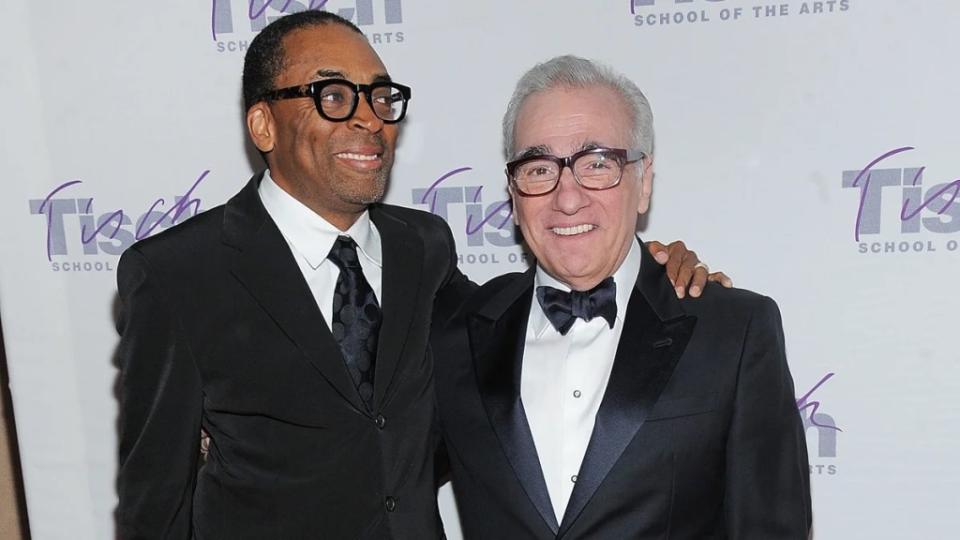
3. NEW YORK UNIVERSITY New York, NY
If you’re looking for an elite film education and want to be on the East Coast, the top program is found at NYU’s Tisch School of the Arts. NYU students don’t just have a world-class city to draw from, but the whole world: The school has satellite campuses in L.A., London, Abu Dhabi, Havana, Paris, Prague and Florence. Nearly 50 countries are represented in the student body. That global outlook is also reflected in the recently established Martin Scorsese Institute of Global Cinematic Arts (founded thanks to a gift from USC grad George Lucas, the largest in NYU’s history). But it’s exceptionally competitive to get in. NYU admits only 8 out of every 100 applicants and tuition runs $66K for undergrads and $70K for grads, though the school says it meets 100% of need for undergrads and 95% of grads get some financial aid. Both the undergrad and grad programs are majority women and the grad program boasts that 70% of its students identify as persons of color (which is also reflected in an alumni base that includes Spike Lee, Chloé Zhao, Ang Lee, Shaka King, Dee Rees and Cary Fukunaga).
4. CHAPMAN UNIVERSITY Orange, CA
The school on the outskirts of L.A. — it’s about an hour from Hollywood, traffic permitting — has its eye on the bottom line. Chapman is touting that its revamped MA program will reduce total tuition costs by $50K per student. For undergrads, it promises that the vast majority get some break on the $62,400 tuition sticker price — the average award for first year students is about $31,000. Chapman also has a Yellow Ribbon program to match GI Bill funds. At a practical level, Chapman has doubled the amount of money it gives for student films (and put mandatory spending caps on every assignment). It funds upwards of 45 undergrad and 19 grad thesis films each year. This emphasis on practicality extends to its intern- ship program, which aims to get every student into one by the end of their sophomore year. Prospective students are taking notice: Applications jumped by more than 500 in the past year. Young alumni making a splash of late include Hannah Einbinder ’17, who scored her second Emmy nomination for Hacks, and Justin Simien ‘05, who directed Disney’s summer movie “Haunted Mansion.”
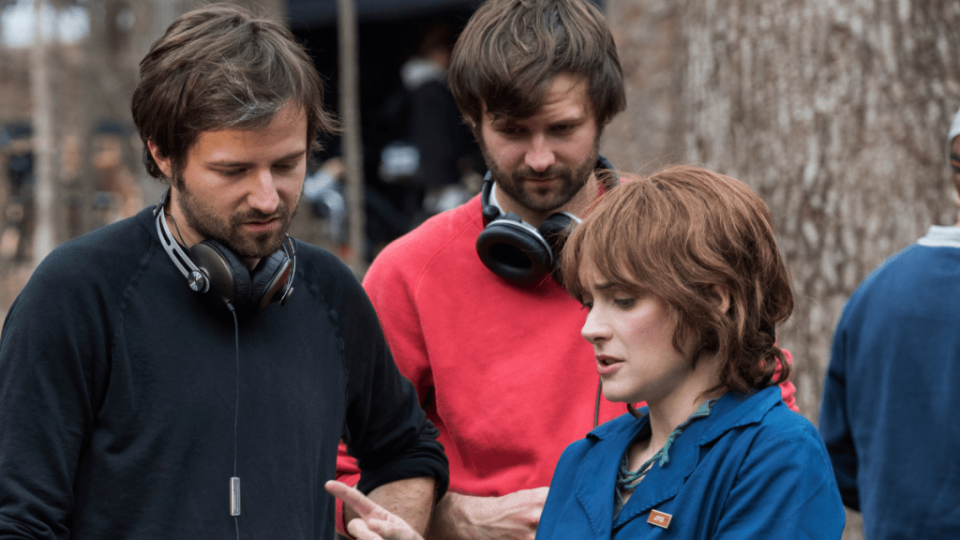
5. LOYOLA MARYMOUNT UNIVERSITY Los Angeles, CA
New dean Joanne Moore, who just finished her first year, has put her stamp on the program after the previous dean’s troubled tenure ended in a faculty revolt. Moore has emphasized making sure “more students have more access” to Hollywood, made easier by the campus’s Playa Vista location. Recently, former WME agent Krista Parkinson ran a career boot camp to coach graduating seniors on getting their first job. The school is also launching a new Masters in Entertainment Leadership and Management this year in conjunction with LMU’s College of Business Administration. Moore introduced a Distinguished Artist in Residence Program, with acclaimed cinematographer Amy Vincent (“Hustle and Flow”) taking the inaugural slot. Moore, the first African American to sit in the dean’s chair, oversees a student body that’s already 56.4% non-white but is 47-53% majority male.
6. EMERSON COLLEGE Boston, MA
Emerson, whose main campus overlooks the magnificent Boston Common, proves there is more to the Hub than Harvard toffs and Southie mobsters. The school has a history almost as rich as the city itself: It counts Henry Winkler, Jay Leno and Norman Lear among its alumni. But it’s not just the old guard killing it. “The Daniels,” the writing/directing team of Daniel Kwan ’10 and Daniel Scheinert ’09, won Best Picture, screenplay and directing Oscars for “Everything Everywhere All At Once,” and ’85 grad Jennifer Coolidge won an Emmy for her work on “The White Lotus.” The 1,700 students in the Department of Visual and Media Arts can also study at the college’s satellite campus in L.A. or enroll in the three-year international BFA program offered jointly with the Paris College of Art that includes classes in Boston, Paris and the Netherlands. Grad students who don’t want to move to Massachusetts full-time can do the school’s MFA in Writing for Film and TV, which combines online classes with short-term resi- dencies in L.A. and Boston.
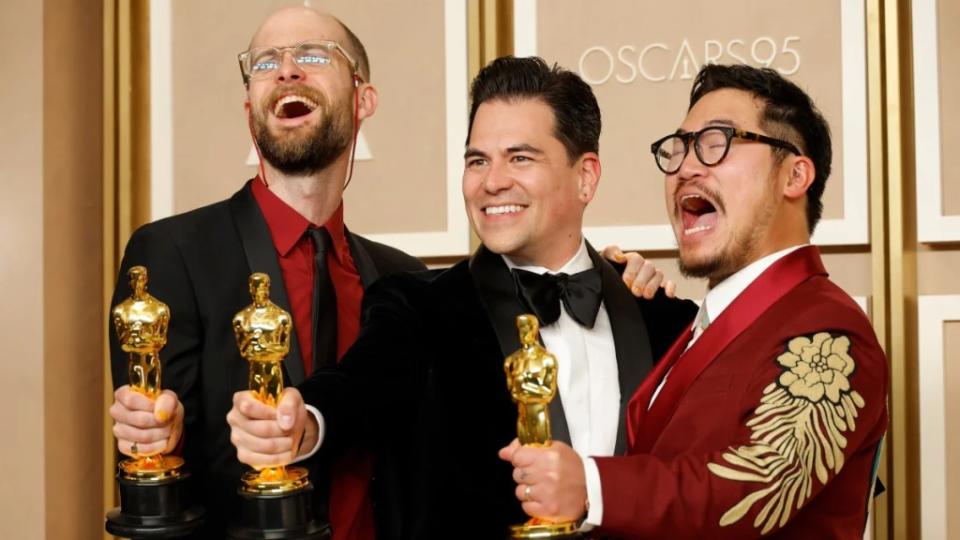
7. California Institute of the Arts (Cal Arts) Santa Clarita, CA
If animation is your jam, CalArts is your place—not surprising for an institution that was born with a push from one Walter Elias Disney (who sadly passed away before it could be fully realized). Animation alums of note include Tim Burton (“Corpse Bride”), Mark Andrews (“Brave”), Brad Bird (“The Incredibles”), Chris Buck (“Frozen”), Pete Docter (“Up”), Genndy Tartakovsky (“Dexter’s Laboratory”) and Lauren Faust (“My Little Pony”). The film program gets over- shadowed but it has produced such notable filmmakers as James Mangold (undergrad), Kirby Dick, James Marsh and Sofia Coppola (who dropped out before graduation). Indeed, the overall graduation rate (61%) is on the low side for an elite institution.
8. COLUMBIA UNIVERSITY New York, NY
The New York City school is the only Ivy League program to land in the top 10, and it draws on all that an Ivy League school can offer in its MFA program. Case in point: the Digital Storytelling Lab, which builds “on a diverse range of creative and research practices originating in fields from the arts, humanities and technology” to understand storytelling in the 21st century. It’s part of what the school says is an intense focus on story and storytelling. The MFA program, which has 267 students enrolled, also touts its collaborative environment, one-on-one faculty guidance and hands-on experience. That emphasis on storytelling is reflected in its high-profile alumni: James Mangold (“Logan”), Nicole Holofcener (“You Hurt My Feelings”) and Kathryn Bigelow (“The Hurt Locker”). Younger alumni making news this year include Olivia Newman ’12 (“Where the Crawdads Sing”) and Ashley Lyle ’07 (“Yellowjackets”).
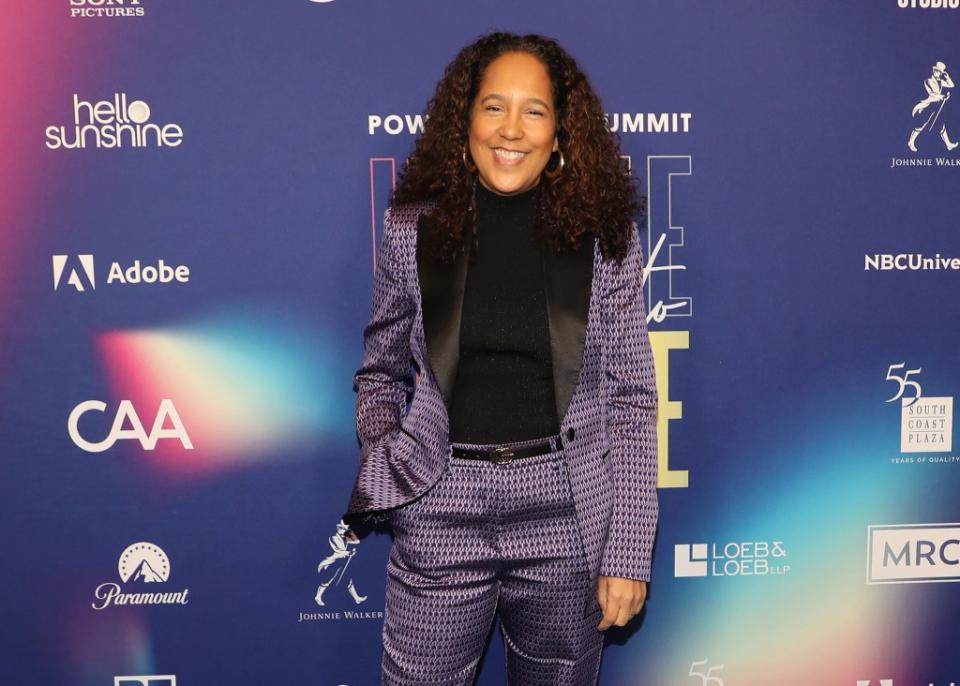
9. UNIVERSITY OF CALIFORNIA, LOS ANGELES Los Angeles, CA
If you’re in-state, it is hard to beat the value of a UC school, especially one that perennially vies for the top ranking among public universities. Tuition for California residents starts at $14,000 for undergrads and $18,000 for grad students. Out-of-state grad students only pay $33,000. That’s a great deal for a world-class film program. Even though UCLA is gigantic — it enrolls 32,000 students — the film program has only 677 students, split about evenly between grad and undergrad, and a 1:3 faculty/student ratio. The program can also point to a stellar list of accomplished graduates, including such luminaries as Alexander Payne, Michael Stuhlbarg, Gina Prince-Bythewood and Catherine Hardwicke. Though the school suspended its graduate film program for the 2021 academic year and has been without a permanent leader since 2019, interim Dean Brian Kite has moved forward with diversity and inclusion efforts, including new scholarships to increase enrollment from underrepresented groups as well as classes in storytelling for diverse voices and the history of African, Asian and Latin-American film. Another small but important improvement: The school just updated its tired website. Reflecting the mental health toll the pandemic has taken on students, the film program also opened a mindfulness space for students.
10. UNIVERSITY OF TEXAS AT AUSTIN Austin, TX
The program at UT Austin has benefitted from Austin being one of the hippest and most creative small cities in the US. South by Southwest might only last for a couple of weeks in March, but the vibe carries over the whole year. Plus, tuition is low: $11K in-state, $39K out-of-state for undergrads and just $9,900/$18,000 for the MFA in screenwriting. Among the cool offerings: a TV writers’ room workshop class where students create an entire season of a series that they then pitch around Hollywood. UTA is in the midst of refreshing all its film equipment, adding new high-end cinema cameras to its stock and new computers in its VFX and CGI labs. It has also made the undergraduate program more practically ori- ented by allowing students to enroll in production classes earlier in their education and adding more industry-focused courses.
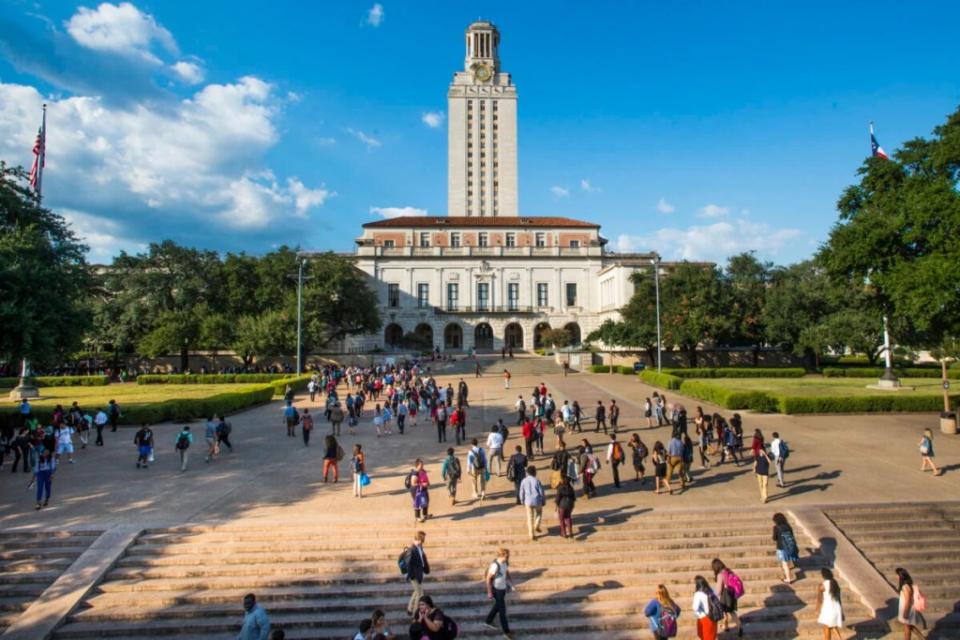
11. University of North Carolina School of the Arts Winston-Salem, NC
UNCSA is having a blast celebrating its 30th anniversary this year — an “Oppenheimer”-sized blast. Because the school houses the fifth largest non-commercial film archive in the country, a team of eight alumni and two staff fanned out across the country to help make sure that movie was shown correctly in locations with 70mm projection facilities. Add to that three alumni in key supporting roles — Dylan Arnold ’16 playing younger brother Frank Oppenheimer, Steve Coulter ’81 as chemist James Conant and Dane DeHaan ’07 as Kenneth Nichols — and you’ve got a great way to ring in UNCSA’s fourth decade. The small school — the enrollment across all disciplines (including music and dance) is only about 800 undergrads and 125 grad students — has big facilities, including Studio Village, a mini backlot and “The Cube” for digital filmmaking, which has a newly installed LED wall. Still, with an endowment around $33 million, it doesn’t have the money that some bigger private schools have. But a state school tuition is a steal: $8,941 in-state/$26,175 out-of-state for the 2023-24 year. On top of that, it just got a $2.2 million grant from the Posse Art Program to support full scholarships for students from underrepresented backgrounds.
12. WESLEYAN UNIVERSITY Middletown, CT
Wesleyan likes to brag that it is “proudly non-specialized” and that it teaches students to “think creatively rather than specialize in narrow skills-based careers.” Would you expect any less from a liberal arts college famed for its unconventional student body? It’s that reputation that attracts great students to Middletown, a.k.a. the middle of nowhere, Connecticut. For a program its size — 115 or so majors — it punches way above its weight in accomplished alumni: Mike White, Paul Weitz, Akiva Goldsman, Michael Bay, Danielle Woodrow (Netflix’s director of original series), Liz W. Garcia (“P-Valley”), Mary Robertson (“Framing Britney Spears”) and, of course, Lin-Manuel Miranda. And it’s not as if the school neglects the practical. Campus facilities include a world-class film archive, soundstage, shooting house and multiple state-of-the-art theaters. But be prepared: It’s one of the most selective liberal arts colleges around, admitting just 14% of applicants whose median SAT score is 1420.
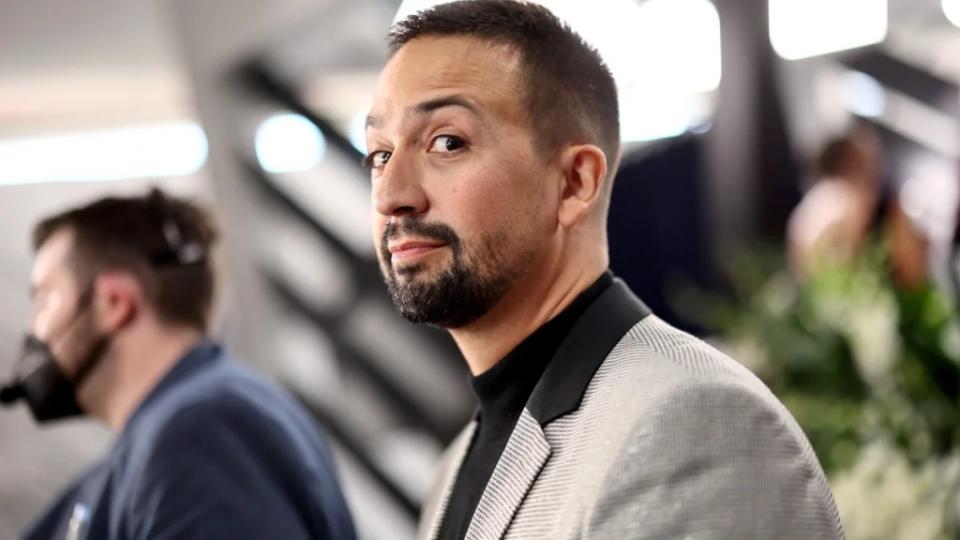
13. SAVANNAH COLLEGE OF ART AND DESIGN Savannah, GA
SCAD is in the midst of an expanding its facilities at the main campus in Savannah (additional campuses are in Atlanta, focused more on screenwriting, and southern France). Upgrades include a new XR stage for digital filmmaking and an 11-acre Hollywood- style backlot with specialized interiors and exteriors that reflect historic Savannah but can sub for other urban areas. The school is also leaning on Georgia’s growth as a production location with its new collaborative experiences class that places students on actual shooting projects. For example, more than 20 SCAD enrollees worked on Todd Haynes’ upcoming Natalie Portman/Julianne Moore starrer “May December.” To go along with the expanded digital facilities, SCAD is introducing a new virtual production minor this year. The school has what it claims is the “the only full- time, in-house university casting office in the nation.” In addition to roles in “May December,” students recently snagged parts in the Apple TV+ series Manhunt and Ava DuVernay’s Neon film “Origin.” Tuition is a reasonable $40K-ish for both undergrad and grad students, but the size — enrollment tops more than 16,000 students — might be a deterrent for some.
14. ART CENTER COLLEGE OF DESIGN Pasadena, CA
The Pasadena institution pitches itself as “a small and nimble film school inside an art and design college” staffed with a professionally active faculty “whose war stories are hours old, not years old.” The program is intimate as well: There are only 90 undergrads and 48 grad students (making up less than 10% of the school’s total enrollment of 2,286). The student body skews male (59% in the undergrad program, 78% in the grad program) and interna- tional (74% of the grad students). New for this year are upgraded filmmaking equipment and additional faculty, including longtime cinematographer Steven Poster. ArtCenter also recently rehabbed its 3,000-square-foot Ahmanson Auditorium, adding digital and 35mm projection equipment among other upgrades that were funded in part by a donation from alum Zack Snyder, who also serves on the board of trustees.
15. Stanford University Palo Alto, CA
If documentaries are your thing, there’s hardly a better place than Stanford. And your first project could be documenting the “Hunger Games”-esque contest to get into the intensive two-year program: Only six to eight students are admitted each year and the odds are no better than 15 to 1. But once in, the rewards are great. Every student is fully funded (including a housing stipend, which is about $12.5K this year) and makes three shorts their first year and one longer, 20-minute doc in the second year. Because of the small size, everyone’s a jack-of-all-trades, shooting, editing, producing, serving as crew. Notable alumni include Elizabeth Lo (“Stray”), Reid Davenport (“I Didn’t See You There”) and David Alvarado and Jason Sussberg (“Bill Nye: Science Guy”). Keep a lookout for recent grads Paloma Martinez, Elivia Shaw, Aurora Brachman, Michael Workman and Adrian Burrell, who all won major awards for their student films.
16. Florida State University Tallahassee, FL
FSU has much to offer, including low tuition, especially for out-of-state undergrads, who only pay $14K a year. (Grad student tuition clocks in at $49K for the film program and $20K for the writ- ing program for those from outside the Sunshine State.) If you decide to go, the film school has FSU’s first mental health spe- cialist embedded in a single program to help deal with stress and work/life balance. The school, recently famous for being the place where alum Barry Jenkins met many of his “Moonlight” team, also says that 96% of graduates work in the industry within a year of matriculating. Other positives include a low 5:1 student/faculty ratio and a new project out of Torchlight Studios, FSU Film’s Center for Innovation and Entrepreneurship, for MFA students that will provide $250,000 in funding and equipment to shoot a student film and put third-year students in charge of mentoring second-year students.
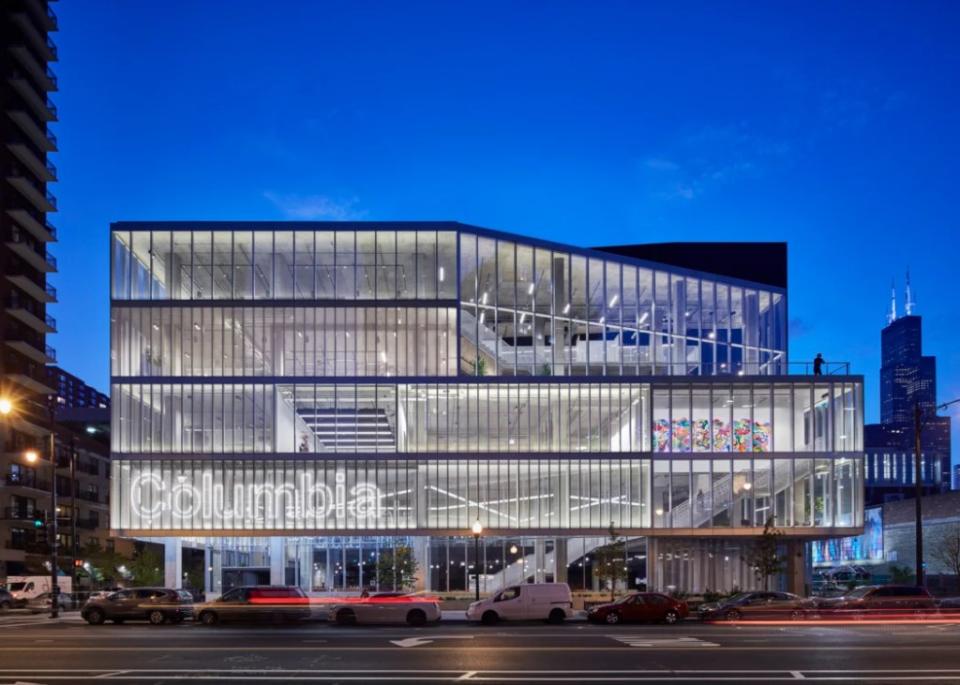
17. Columbia College Chicago Chicago, IL
America’s third-largest city often gets overlooked when talking about shooting locations, but as Dick Wolf has demonstrated, it’s a great location: His One Chicago franchise has filmed 30 seasons across four series there since “Chicago Fire” debuted in 2012. And Columbia College Chicago provides a top-notch education. Indeed, the school makes a virtue out of what some might see as a vice: It’s an urban location that lacks an old-school-style campus. “This isn’t your traditional campus — and we think that’s exciting,” the school said in a statement. “The campus stretches just over a mile from north to south and is approximately three blocks wide. You’ll find everything you need within walking distance: classes, cultural destinations, grocery stores, restaurants and more.” Columbia College also has an L.A. satellite campus housed at Sunset Las Palmas studios (“I Love Lucy” was shot there), where students can spend a semester. New this year is a proposed minor in virtual production and a BA in Sound Design for Cinema. On tap for 2025 is a new BFA in Film and Television that offers students “a more focused dive into the study of narrative film and television production and industry processes.” Tuition is on the affordable end for private schools: low $30K for both undergrad and grad. And if you’re worried about getting in, don’t sweat it. The school admits more than 90% of its undergrad applicants.
18. California State University, Northridge Northridge, CA
CSUN has ambitions for its Department of Cinema & Television Arts. It has added a new, fully online grad program in entertainment management; started a documentary program and mentor- ship program for underserved screenwriting students; and is creating an advisory board for its Entertainment Industry Institute to build better pathways for internships and postgraduate employment. On the facilities side, it just added a large virtual production LED wall (thanks to a generous donation from ROE Visuals). All that, combined with its location (just 25 miles from the Hollywood sign) and its affordable tuition (in-state is just $7K for undergrads, $8.4K for grads), make CSUN an excellent option for many.
19. SYRACUSE UNIVERSITY Syracuse, NY
Syracuse offers both BFA and MFA degrees in film through its College of Visual and Performing Arts and BS and MA degrees in television, radio and film through its S.I. Newhouse School of Public Communications. Syracuse is probably best known for its high-profile Newhouse alumni (Bob Costas, Ted Koppel, Dick Clark), but VPA alumni are no slouches: Aaron Sorkin, Vera Farmiga and Jerry Stiller. VPA focuses on “independent filmmaking” but offers semester study programs in N.Y. and L.A. And while Syracuse can seem far from Hollywood, the school has partnered with local company American High Studios (which has a first-look deal with Hulu) to offer students real-world experience as interns. Newhouse introduced new tracks in production, business, innovations and screenwriting in the last year. SU also upgraded its campus facilities, adding a green screen and stop-motion animation studio, among other improvements.
20. BOSTON UNIVERSITY Boston, MA
The School of Film and Television keeps growing — there are more than 600 undergrad majors now. But it offsets that with a commitment to smaller classes (usually 12-16 students) and a flexible approach that encourages students to design their course of study around their interests. The grad program remains relatively intimate, with about 50 students total. In a joint program with the School of Theatre, SFT created a sitcom pilot called “Art House” that shot in front of a live studio audience. The school also revamped its screenwriting and production classes to be geared toward social purpose and encourage “students to engage with the pressing issues of the day,” as they explained it. BU also just completed a $500K renovation of two studios in its main building, adding upgraded cameras and lighting.

21. UNIVERSITY OF MIAMI Miami, FL
Miami’s Cinematic Arts program offers an undergraduate major and an MFA in narrative documentary practice (in collaboration with the Department of Journalism). On the practical side for undergrads is the introduction this fall of a new track in TV writing. The school also offers an L.A. semester option and film- study abroad programs in Greece, Guatemala, the Czech Republic and Japan. Notable alumni include directors David Nutter (“Game of Thrones”) and Kyle Patrick Alvarez (“13 Reasons Why”), producer Adam Kolbrenner (“Free Guy”) and writer David Isaacs (“Frasier,” “The Simpsons”).
22. NORTHWESTERN UNIVERSITY Evanston, IL
How many schools can say that if you study here, you can go on to marry a prince and become a duchess? Thanks for setting the bar that high, Meghan Markle ’03. (Truth is, most Northwestern kids probably admire her more for her career success on “Suits” than taking one of the world’s most eligible bachelors off the market.) As befits one of the most prestigious schools in the country (the overall acceptance rate for undergrads is 7%), many of this year’s new initiatives tackle weighty topics: a cross-disciplinary effort to explore “new ways of depicting what it means to live and die within a changing climate, right now,” plus a media and mental health program and “Murders That Matter,” a doc about a trauma survivor-turned-gun control activist that was directed by professor Marco Williams and aired on PBS. It’s all in line with the school’s emphasis on interdisciplinary study, well-rounded students and a mix of theory and practice. At 250 students, the Department of Radio/Television/Film (housed in the School of Communication) is a relatively small part of the larger university of 14,000 undergrads. All MFA programs are fully funded so grad students attend tuition-free.

23. RINGLING COLLEGE OF ART AND DESIGN Sarasota, FL
Despite the name — yes, the founder was one of the famous circus brothers — this is no clown show. Ringling has been on the leading edge of teaching computer animation for four decades (claiming 17 Student Academy Awards in the field), and it added a well-regarded and relatively intimate (just 35-45 students per class) film program 15 years ago. That program concentrates on two tracks: narrative and, uniquely, branded entertainment. The overall emphasis is on experiential learning. Ringling says that because of the small size of the undergrad program, by graduation most film majors will have worked on 50 to 60 student films in almost every capacity. The excellent facilities, including five soundstages and more than a dozen editing suites, attract working professionals like Werner Herzog and Kevin Smith and have been an informal jobs pipeline for students.
24. UNIVERSITY OF ARIZONA Tucson, AZ
The School for Theatre, Film and Television (TFTV) offers diverse opportunities to its 318 majors (nearly half of whom identify as non- white and a quarter as first-generation col- lege attendees) — from collaborating with UA’s nationally recognized acting school to working with acclaimed faculty filmmakers (professors Jacob Bricca and Lisa Molomot won a 2023 Peabody Award for their documentary “Missing in Brooks County” and Greg Pierotti staged a new version of his cowritten play “The Laramie Project”). There’s a sneaky long list of prominent alumni from UA — not surprising, given the school’s beautiful Tucson location and laidback reputation: “Dark Winds” EP Chris Eyre, WME partner Brad Slater, “Rutherford Falls” showrunner Sierra Teller Ornelas, actor Greg Kinnear and “Mare of Easttown” editor Amy Duddleston.
25. ITHACA COLLEGE Ithaca, NY
In the early 1970s, a young student at the Roy Park School of Communications dreamed of becoming a news anchor but settled for a job as a weatherman at a local station. Turns out he wasn’t great at it and soon switched careers. But don’t worry for that fellow. The education Bob Iger received at Ithaca — he graduated Magna Cum Laude — helped him become the head of Disney. (Among the other well-known alumni: David Boreanaz, Bill D’Elia and Liz Tigelaar.) The school empha- sizes experiential learning, encouraging students to dive right into making their own productions using the schools’ state-of-the-art equipment and a virtual soundstage “cube” that allows for the cre- ation of digital backgrounds. Students can also spend a semester in an L.A.-based program to gain hands-on professional experi- ence. For students worried about cost—tuition runs about $50K per year—Ithaca boasts that an impressive 100% — that’s right, 100% — of incoming students received some form of merit or need- based financial aid in 2023.
26. RHODE ISLAND SCHOOL OF DESIGN Providence, RI
The Rhode Island art school is famous for its eclectic bohemian student body. This is, after all, the college that gave us Jenny Holzer, Seth MacFarlane and three-quarters of the Talking Heads. The Film, Animation, Video Department established a movement lab this year to help animators and effects artists advance their work. The lab is an extension of the program’s philosophy to go beyond teaching students to use film technology and get them “to master the use of tools by focusing on concepts, critical thinking and content development.” As part of that, Cheryl Henson, daughter of Jim and mother to a current student, funded an endowment to bring in a visiting puppeteer each year.
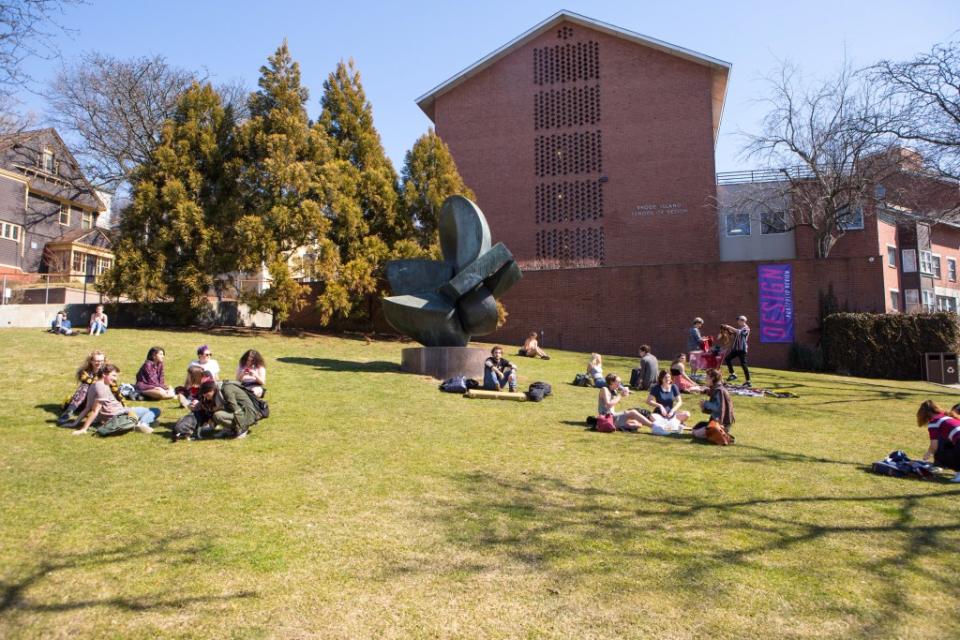
27. RUTGERS New Brunswick, NJ
One of the jewels of the Rutgers film program is its Documentary Film Lab, which gives students the chance to make full- length, festival-worthy docs and is led by Academy Award- winner Thomas Lennon (“The Blood of Yingzhou District”). To keep in line with other schools, the Mason Gross School of the Arts is building a VR studio/lab and developing such courses as “New Technologies in Cinema” and “Community-Engaged Filmmaking.” Rutgers students also benefit from its proximity to NYC (just up the Jersey Turnpike) as well as a growing studio presence in the Garden State, highlighted by Lionsgate’s complex in Newark and Netflix’s Fort Monmouth studio. While Rutgers itself is ginormous (67,000 students!), the grad film program is intimate, with just 33 people enrolling last year.
28. STONY BROOK UNIVERSITY New York, NY
Unlike the BFA program, which is located on the school’s subur- ban Long Island campus, MFA students are housed at the school’s Lichtenstein Center in midtown Manhattan. Formidable indie producer Christine Vachon (see cover story) oversees the MFA film program, while Alan Kingsberg runs a touted MFA in TV Writing program that features an extensive 18-course offering and A-list guest lecturers (Ashley Lyle, Marti Noxon, Anya Epstein, Davita Scarlett, Erica Saleh). For grad students, tuition runs $13K in-state, $27K out-of-state, but the school has created 17 small scholarships designed to distribute aid more widely, which is helpful in a program that has doubled in size in the last few years.
29. DePAUL UNIVERSITY Chicago, IL
The largest Catholic university in the U.S. really leans into its Chicago roots. It added six annual grants for MFA students sponsored by artists with DePaul and/or Chicago connections; for 2023, those were Bob Odenkirk, Ava DuVernay, Gillian Anderson, John C. Reilly, Michael Peña and Steve James. It has sound stages at Cinespace, the city’s main professional production facility where Netflix, Amazon and Dick Wolf all film; collaborates with Second City; and this year, as part of a partnership with the Chicago Housing Authority, brought three high school filmmakers to Cannes. Film is one of the most popular majors on campus, and the school has strong retention and graduation rates, though overall finances are tight: It faced a $52M budget gap this spring.

30. PRATT INSTITUTE Brooklyn, NY
Located just 25 minutes from Manhattan, Pratt, the only art and design school in NYC with a traditional physical campus, mixes a historic classic college look with stellar facilities that include three soundstages, editing suites and a 90-seat 4K screening room. It also has accomplished faculty: Professor and filmmaker Eliza Hittman (“Never Rarely Sometimes Always”) was a juror at Sundance this year, alongside indie directors like Matías Piñeiro (“Hermia & Helena”) and Jim Finn (“The Drunkard’s Lament”). Being in NYC means visits from filmmakers like Kelly Reichardt, Werner Herzog, Jim Jarmusch, Lucrecia Martel, Alice Rohrwacher and Charles Burnett for its filmmaker Q&A series.
31. HOFSTRA UNIVERSITY Hempstead, NY
With 220 majors, the film program, housed in the Lawrence Herbert School of Communication, has grown more than 25% in the last decade. The annual student film festival — going on its 27th year — is a great showcase for senior thesis projects. Adjunct to the film program, Herbert just launched a Sports Media BS program this year. The school has recently introduced a BFA in film that mixes practical instruction in production with film history and theory and a Writing for the Screen BFA. The dean’s advisory board for the Herbert School includes such Hollywood players as Criterion Collection CEO Jonathan Turell; Magical Elves Co-CEO Jo Sharon, Sony SVP Eric Lempel and CAA Agent Bryan Diperstein. Among the notable alumni are Anonymous CEO Dawn Olmstead, producer Avi Arad and a local boy made good named Francis Ford Coppola.
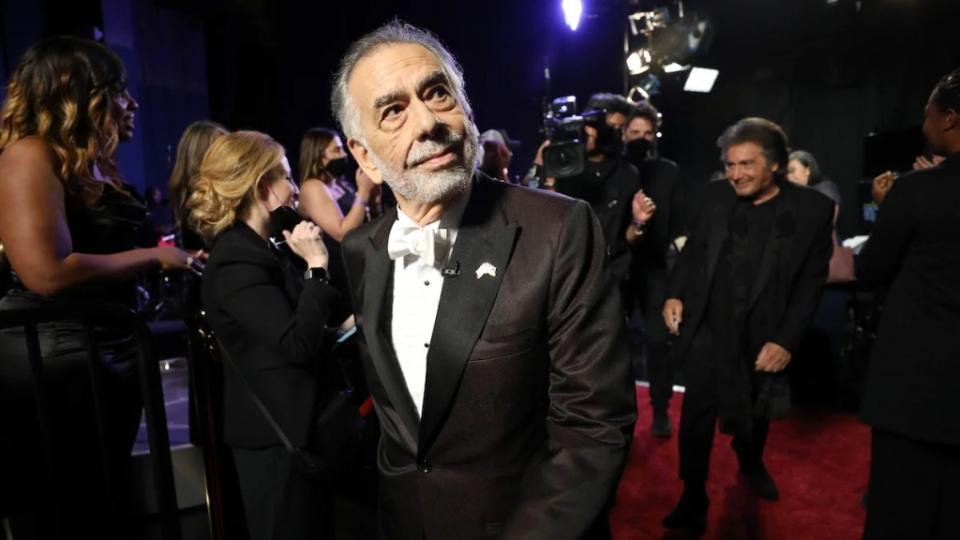
32. SAN FRANCISCO STATE UNIVERSITY San Francisco, CA
Founded during the height of 1960s counterculture, SFSU empha- sizes creative expression that feels very SF: “Although we teach the ‘rules’ of fictional, documentary, experimental and interactive cin- ema using all media platforms … we encourage our students to take creative risks” to develop a critical consciousness and be socially engaged. In addition to the majors in media studies and cinema, SFSU offers documentary and animation minors. The program attracts more than 900 undergraduate majors and upwards of 40 graduate students. A recent gift has funded the creation of two new endowed chairs and the new screening room was named for former dean August Coppola (who happens to be Francis’ big brother).
33. LOS ANGELES FILM SCHOOL Los Angeles, CA
This for-profit school is a practical-oriented and affordable L.A. alternative founded in 1999 by a group of Hollywood professionals. Tuition varies across its 13 online and in-person BS and AS degrees but runs in the $15K-$25K per-year range. More than 70% of the school’s 5,500 full-time students are enrolled in an online pro- gram (per 2022 government reporting) and that, combined with the school’s lack of a traditional campus (it’s housed in the old RCA building where Elvis and the Stones recorded, and has studio space a few blocks away) helps account for its lower first-year retention (56%) and graduation (46%) rates. The school has invested in building community and creating connections between students through a “robust social calendar” ranging from Zoom mixers to trivia nights to industry speaker forums. Still, LAFS recently celebrated its first ever alumni Oscar — to “Sound of Metal”’s Phillip Bladh for Best Sound in 2021 — which not every school can claim.
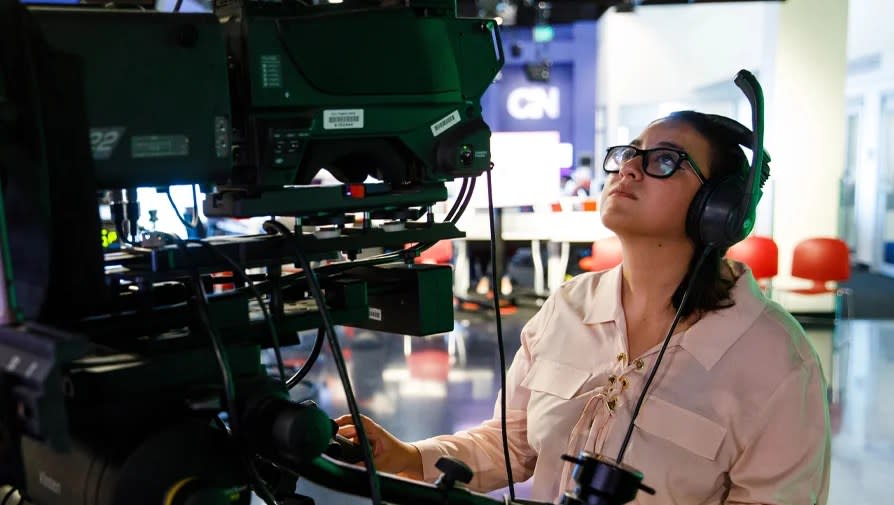
34. ARIZONA STATE UNIVERSITY Tempe, AZ
The ASU film program, recently upgraded to a school within the university, touts itself as something new — it’s right there in the name, the Sidney Poitier New American Film School. The school is dedicated to inclusivity and diversity (more than 40% of the 1,000 undergraduate film majors are from underrepre- sented backgrounds) and has facilities in three cities, including a 118,000-square-foot extravaganza in Mesa (seven miles from the main Tempe campus) and a satellite campus in L.A. There’s still plenty of traditional Hollywood here: Former Academy president Cheryl Boone Isaacs is the founding director and producer Peter Murrieta (“Wizards of Waverly Place”) is her deputy. Another positive: Arizona, which during the golden age of the Western was the third biggest shooting state after California and New York, recently revived its state film office in an effort to attract more productions.
35. SCHOOL OF VISUAL ARTS New York, NY
SVA aims to create working filmmakers — from first-year students who start making films on day one to seniors who get access to “industry standard” equipment for their thesis films to post-graduation help with film-festival fees. On the festival circuit, one leg up for SVA students is the fact that the school is a sponsor of the New York Film Festival, which gives top student projects automatic admission. SVA also recently redesigned its BFA program to give students more flexibility in choosing classes. Animation courses are highly regarded.
36. University of California, Santa Barbara Santa Barbara, CA
The Department of Film and Media Studies is celebrating its 50th anniversary this year. The school is primarily focused on schol- arship, not surprising for a place that moved past its party-hard reputation to become a world-class research institution. For its 600 or so majors, it offers a wide variety of production-oriented offerings, including a two-quarter course in which students make films in a crew. The department is also closely affiliated with the Carsey-Wolf Center, which engages in research and programming around new forms of media literacy in an interconnected world via events, classes, internships and publications. (In case it wasn’t clear, that’s Marcy Carsey of “Roseanne” fame and Dick Wolf of “Law & Order” fame.)
37. UNIVERSITY OF CALIFORNIA, BERKELEY Berkeley, CA
Berkeley’s Department of Film & Media works to combine theory and practice in its teaching, leaning into the idea of the school as a hotbed of criticism (Pauline Kael got her start at here as a film reviewer, as did several important arty film magazines.) Film is one of the fastest-growing majors on campus, having jumped 120% in the last few years — a rise that coincides with the school dropping the foreign-language requirement designed to boost students’ understanding of international cinema. It also boasts that half its majors are community college transfers.
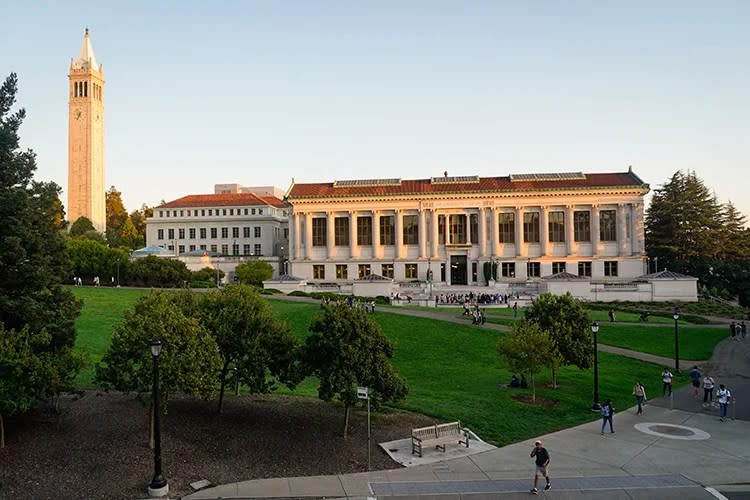
38. UNIVERSITY OF MICHIGAN Ann Arbor, MI
Michigan approaches film studies as a traditional liberal arts sub- ject rather than a vocational pursuit, but it has fully kitted-out production facilities. The jewel of the program is its more professionally oriented screenwriting track, overseen since its 1995 founding by the screenwriter alum Jim Burnstein (“Renaissance Man,” “Love and Honor”). The broader program has doubled in size over the last five years, helped by a $5 million gift from the descendants of another alum, Columbia Pictures Television founder John H. Mitchell. Younger alums making a splash include actors Ashley Park (“Emily In Paris”), Yuri Sardarov (“Chicago Fire”) and Jacqueline Toboni (“Grimm”) and writer Amanda Adelson (“The Dirt”).
39. AMERICAN UNIVERSITY Washington, DC
This film program, strong in the documentary arena, squeezes everything it can from its D.C. location. That includes internships around the 2024 campaign, a fellowship centered on bridging the gap between film and investigative journalism and a Center for Environmental filmmaking. There’s the cool “classroom in the wild,” which introduces students to the fun and challenge of envi- ronmental filmmaking; an exchange program with the Academy of Performing Arts in Prague; and weeklong, career-oriented pro- grams in L.A. and New York.
40. UNIVERSITY OF PENNSYLVANIA Philadelphia, PA
Film has been newly upgraded from program to department — meaning more faculty and degree-granting grad offerings and a higher profile on campus. Penn embeds its film study within the liberal arts, so it emphasizes formal analysis, history and critical engagement. But it also offers real-world exposure like a summer program at the Cannes Film Festival. Among Penn’s celebrated alumni are WGA West President Meredith Stiehm, who helped lead the union through the recent strike; uber producer Dick Wolf; and Oscar-winning documentary director Morgan Neville.
41. SCHOOL OF THE ART INSTITUTE OF CHICAGO Chicago, IL
More than any other film school, SAIC promotes its avant-garde, artsy ethos. It’s the only school on the list that promotes how the work of faculty and students has been represented in museums and galleries — there’s even a new media gallery in the school’s art museum. Founded as a student art cooperative in 1886, the Art Institute’s Department of Film, Video, New Media & Animation emphasizes “challenging convention,” encouraging “experi- mentation with radical form and content” and an international perspective.
42. BIOLA UNIVERSITY La Mirada, CA
Biola, a private nondenominational evangelical Christian university about 25 miles from Hollywood, is breaking ground on a new 55,000 square-foot facility made possible by a donation from Lynsi Snyder-Ellingson, the president of In-N-Out Burger who is now part of the institution’s name: the Snyder School of Cinema & Media Arts. The dean is TV industry veteran Tom Halleen, who left his job as head of programming strategy, acquisitions and scheduling at AMC Networks to take the position. With 406 majors in 2023, the program is still relatively small, but the Snyder school has seen enrollment climb a dazzling 68.5% since 2017.
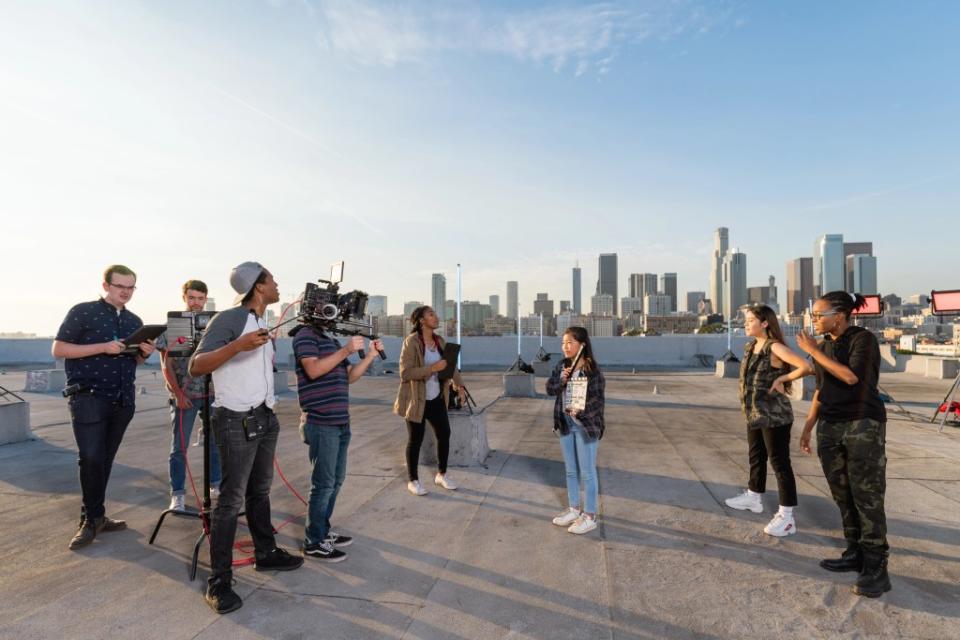
43. FULL SAIL UNIVRSITY Winter Park, FL
The for-profit school offers bachelor’s degrees in film and digital cinematography and an MFA in film production. Full Sail has an impressive 880,000 square feet of production facilities, including more than 110 studios and labs. It aims to move students through the program quickly with a mix of in-person and online courses: The digital cinematography major is entirely online and an under- graduate film degree can be completed with just 20 months on campus and another 29 months virtually. Classes tend to be on the larger side and while undergrad tuition is a competitive $40K per year, Full Sail did not disclose financial aid data. Still, it has two Oscar-winning alumni, both for sound mixing.
44. University of Colorado at Boulder Boulder, CO
“South Park” creators Matt Stone and Trey Parker (who won a Student Academy Award while at Boulder) launched their careers here and still remain close enough to the state to have rescued the legendary Casa Bonita restaurant in nearby Lakewood from closure. The Department of Cinema Studies & Moving Image Arts mixes a liberal arts approach to film study with practical train- ing, with an emphasis on indie filmmaking. (“Repo Man” director Alex Cox, now retired, spent years there as a professor.) Boulder also leans into film — not the idea, but the actual stuff: This year it hosted a festival celebrating a century of 16mm filmmaking.
45. NEW YORK FILM ACADEMY New York, NY
Though it fronts New York in its name, this for-profit school that offers both BAs and MAs has campuses in L.A., Miami, Italy and on Australia’s Gold Coast, plus satellite locations in Paris and Beijing, a summer program at Harvard (yeah, that Harvard) and an online option. The school, which celebrated its 30th anniversary in 2022, was founded by “The Hunt for Red October” producer Jerry Sherlock, as (in its own words) “an alternative to traditional university-based film schools,” and was “designed to demystify and democratize the highly competitive filmmaking industry.” Tuition varies by program but as an example, a BFA in filmmaking will run $32K in the 2024-25 school year. Among its alumni are Oscar-winning cinematographer James Friend (“All Quiet on the Western Front”), director Mohamed Diab (“Moon Knight”), Issa Rae and Bill Hader.
46. COLORADO FILM SCHOOL Denver, CO
The Colorado Film School recently restructured to become the Cinematic Arts Department at Aurora Community College rather than a stand-alone school after the educational accreditation orga- nization raised questions about its ability to grant degrees and its $2 million program deficit. For now, it appears it’s a change for the better. The school has emphasized that the on-ground experience for the students isn’t changing and it likely helps long-standing plans to expand the two-year AS degree into a full, four-year BA. The program is a bargain (tuition for an AS degree is about $15K) that has produced a student Academy Award finalist and an Emmy nominee.
47. MOUNT ST. MARY’S Los Angeles, CA
This private Catholic university is for women only at the undergraduate level but admits men to its graduate programs. In addition to its main campus in Brentwood, the school partnered with Sunset Studios parent company Hudson Pacific Properties to build a cutting-edge studio facility on Hollywood Boulevard that overlooks the TCL Chinese Theater, extending a partnership that began in 2014. Mount St. Mary’s is also developing a new MFA in screenwriting in collaboration with the creative writing program. For undergrads, there’s a three-semester “production workshop experience” class cycle that goes from writing/development as a summer course to production in the fall and post-production in spring and results in a series of student-made shorts.
48. UNIVERSITY OF WISCONSIN, MILWAUKEE Milwaukee, WI
With 530 film majors, plus another 80 concentrating in animation, the Department of Film, Video, Animation and New Genres is one of UWM’s fastest-growing programs. The school offers a generous array of facilities, including a green screen room, a black box pro- duction space and a specialized animation lab. While Milwaukee isn’t a hub of filmmaking, the campus is in a beautiful residential neighborhood in a city that offers a vibrant array of arts and recre- ational activities. The tuition, even for out-of-state students ($14- 22K), is a bargain.

49. JOHNS HOPKINS UNIVERSITY/MICA Baltimore, MD
The Baltimore-based program, jointly operated by Johns Hopkins and the Maryland Institute College of Art, is based in a century-old building that once housed a car dealership and then a theater and boasts a 49-seat screening room, a 2,000-square-foot green screen stage and dedicated editing suites. A recent $2 million gift has fully endowed the annual week-long intersession trip to Los Angeles for film majors to network and seek internships, but the school has plans to add a full semester in L.A. option in 2025. Like many of the liberal arts colleges and universities on the list, the film program combines practical instruction with a strong empha- sis on critical thinking and writing skills.
50. MOREHOUSE UNIVERSITY Atlanta, GA
The Historically Black Colleges and Universities are getting increasingly into the arena of film and media, and the all-male university that graduated Martin Luther King, Jr., Samuel L. Jackson and a pre-NYU Spike Lee is at the forefront with its Cinema, Television and Emerging Media Studies department, which makes this list for the first time. The focus is on screenwriting, but CTEMS also includes instruction in film and television history, cinematic language, film production, film theory, producing and global cinema, classic Hollywood cinema and African American film studies.
Read more from the College Issue here.
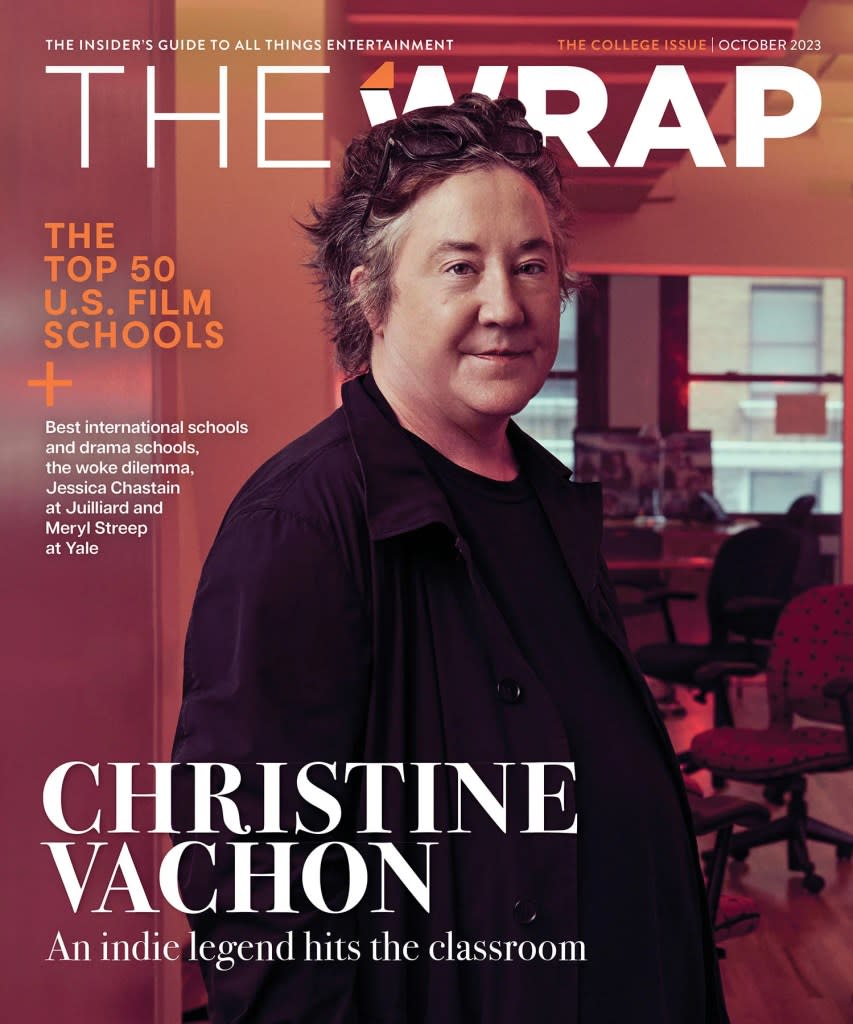
The post TheWrap’s Top 50 Film Schools for 2023 appeared first on TheWrap.

